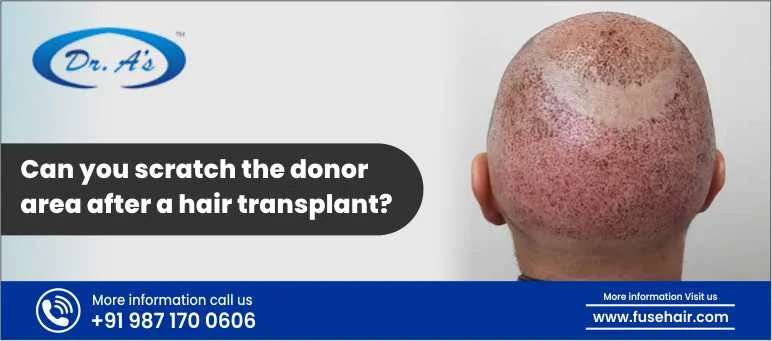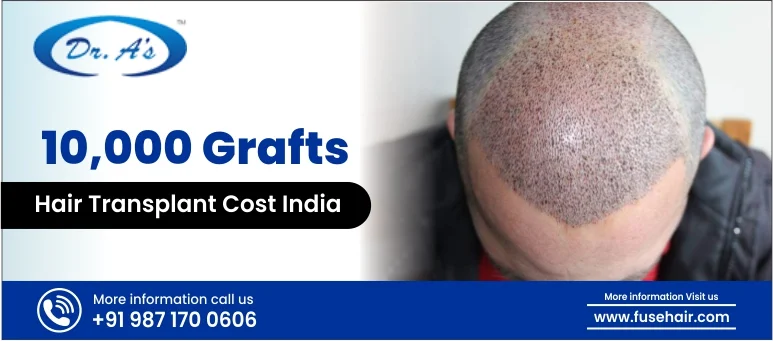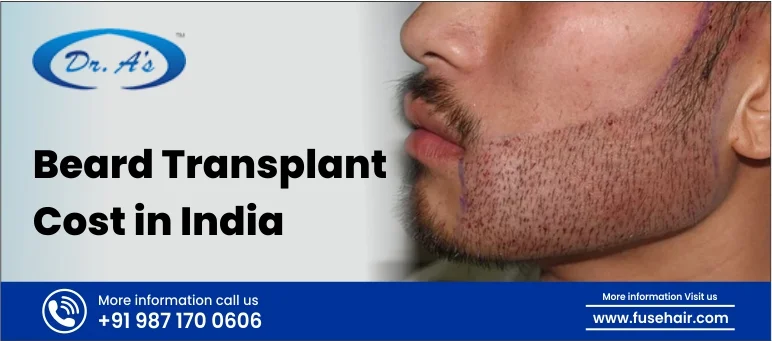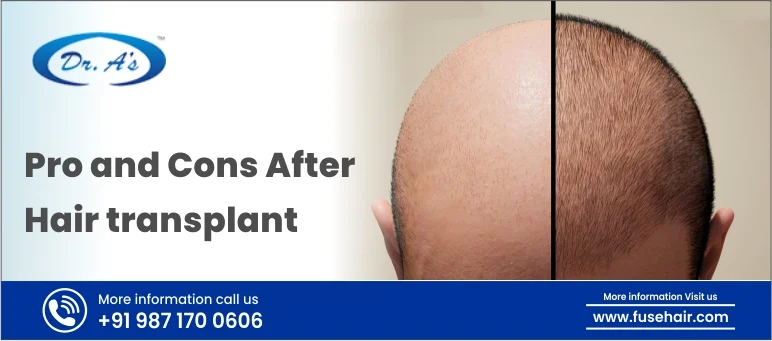
Hair loss can be a distressing experience for many individuals, impacting self-confidence and overall well-being. While there are various treatments available, hair transplant has emerged as a popular solution for restoring natural-looking hairlines. However, one significant consideration for anyone considering this procedure is the hair transplant cost. Understanding the factors that influence the hair implantation costs is crucial for making an informed decision.
Hair Transplant Cost
Here, we provide the hair transplant cost in India depending on the baldness grade and number of grafts required:
| Baldness Grade | Required Number of Grafts | Cost of Transplant |
| 1st Grade of Baldness | 700-1200 | INR 22,000 to INR 40,000 |
| 2nd Grade of Baldness | 1500-1800 | INR 29,000 to INR 50,000 |
| 2A Grade of Baldness | 1100-1500 | INR 30,000 to INR 55,000 |
| 3A Grade of Baldness | 1500-1900 | INR 40,000 to INR 60,000 |
| 4th Grade of Baldness | 1400-2300 | INR 32,000 to INR 65,000 |
| 4A Grade of Baldness | 1800-2500 | INR 45,000 to INR 70,000 |
| 5 Grade of Baldness | 2000-2500 | INR 50,000 to INR 80,000 |
| 5A Grade of Baldness | 2200-2800 | INR 55,000 to INR 1,00,000 |
| 6th Grade of Baldness | 2400-3000 | INR 58,000 to INR 1,30,000 |
| 7th Grade of Baldness | 2500-3200 | INR 70,000 to INR 1,75,000 |
Cost of Hair Transplant in Different Cities in India
Here is the cost of hair transplant price per graft in different cities across India:
| Cities | Cost of Hair Transplant (INR) |
| Bhubaneswar | 45,000 to 1,35,000 (INR 20 to 100 per graft) |
| Kolkata | 35,000 to 1,15,000 (INR 25 to 35 per graft) |
| Noida | 30,000 to 1,20,000 (INR 30 to 45 per graft) |
| Gurgaon | 80,000 to 1,20,000 (INR 40 to 100 per graft) |
| Ghaziabad | 80,000 to 1,30,000 (INR 34 to 50 per graft) |
| Kanpur | 50,000 to 1,00,000 (INR 25 to 45 per graft) |
| Ludhiana | 80,000 to 1,10,000 (INR 20 to 45 per graft) |
| Jaipur | 75,000 to 1,00,000 (INR 40 to 45 per graft) |
| Mangalore | 59,000 to 1,60,000 (INR 25 to 120 per graft) |
| Udaipur | 60,000 to 1,30,000 (INR 25 to 55 per graft) |
| Chandigarh | 80,000 to 1,70,000 (INR 40 to 100 per graft) |
| Kota | 85,000 to 1,45,000 (INR 32 to 90 per graft) |
| Ahmedabad | 70,000 to 1,40,000 (INR 34 to 50 per graft) |
| Lucknow | 50,000 to 1,00,000 (INR 25 to 45 per graft) |
| Nagpur | 80,000 to 1,10,000 (INR 20 to 45 per graft) |
| Hyderabad | 75,000 to 1,00,000 (INR 40 to 45 per graft) |
| Amritsar | 70,000 to 1,80,000 (INR 35 to 120 per graft) |
| Nashik | 50,000 to 1,10,000 (INR 15 to 60 per graft) |
| Delhi | 40,000 to 2,40,000 (INR 30 to 190 per graft) |
| Mumbai | 95,000 to 1,75,000 (INR 45 to 140 per graft) |
| Pune | 90,000 to 2,10,000 (INR 50 to 120 per graft) |
Hair Transplant cost per graft
Here is the hair grafting price in India in its major cities:
| Number of Grafts | Techniques | Delhi | Mumbai | Pune | Bangalore |
| Less than 1000 grafts | FUE, FUT, BHT | INR 23 – INR 80 | INR 30 – INR 120 | INR 40 – INR 110 | INR 50 – INR 150 |
| 1000 to 1500 Grafts | FUE, FUT, BHT | INR 23 – INR 80 | INR 30 – INR 120 | INR 40 – INR 110 | INR 50 – INR 150 |
| 2000 Grafts | FUE, FUT, BHT | INR 23 – INR 75 | INR 30 – INR 100 | INR 40 – INR 110 | INR 50 – INR 150 |
| 3000 Grafts | FUE, FUT, BHT | INR 20 – INR 75 | INR 30 – INR 100 | INR 40 – INR 100 | INR 50 – INR 120 |
| 4000 Grafts | FUE, FUT, BHT | INR 23 – INR 70 | INR 30 – INR 90 | INR 40 – INR 100 | INR 50 – INR 120 |
| 5000 Grafts | FUE, FUT. BHT | INR 23 – INR 70 | INR 30 – INR 90 | INR 40 – INR 90 | INR 50 – INR 90 |
| 6000 Grafts | FUE, FUT, BHT | INR 23 – INR 70 | INR 30 – INR 90 | INR 40 – INR 90 | INR 50 – INR 90 |
Why is Hair Transplant expensive?
Hair transplant charges in India are high because of the following factors that directly affect its cost:
-
Number of Hair Follicles per Graft
The cost is calculated based on the number of hair follicles implanted, with each follicle containing 1 to 3 hairs, varying from person to person.
-
Hair Loss Stages
Hair loss is categorized into 7 stages of baldness. As baldness progresses, more hair follicles are required for transplantation, increasing the overall cost.
-
Hair Transplant Technology
Different technologies like DHT and FUE impact costs. FUE, preferred by patients due to its scarless nature, involves individual extraction and implantation of follicular units, contributing to higher costs.
-
Baldness Stage
The degree of baldness directly affects the cost. More extensive baldness requires a larger number of hair follicles to cover bald spots, driving up expenses.
-
Nursing Staff
A team of professionals is essential for a successful hair transplant, each with specific responsibilities in follicular unit preparation and selection, adding to the overall cost.
-
Experience of the Surgeon
Surgeon expertise and reputation significantly influence costs. Experienced and renowned surgeons command higher fees, contributing to overall expenses.
-
City-specific Factors
Costs vary across cities due to factors like taxes, standard of living, surgeon wages, and center expenses. Operations in cities with higher living standards tend to be more expensive.
FUE Hair Transplant Cost
The Follicular Unit Extraction (FUE) hair transplant procedure involves several steps:
- Preparation: Your surgeon will prepare the donor and transplant areas by shaving the hair to ensure precise extraction and transplantation.
- Extraction of Follicles: Using a micro punch tool, the surgeon meticulously extracts individual follicular units from the donor area, typically located at the back or sides of the scalp. These follicular units contain 1 to 4 hairs each.
- Creation of Incisions: Next, the surgeon creates tiny incisions in the recipient area where the extracted follicles will be implanted. These incisions are made using a needle or other small, sharp tool, ensuring minimal trauma to the scalp.
- Implantation of Follicles: The surgeon delicately inserts the extracted follicles into the prepared incisions, paying close attention to the angle, depth, and direction for natural-looking results.
- Post-Procedure Care: Once all follicles are implanted, the surgeon cleans the scalp and applies bandages to protect the treated area during the initial stages of recovery.
Here is the cost of the FUE procedure per graft:
| Number of Hair Grafts | Cost of FUE Method (Per Graft) | Sessions Required |
| 500 – 1000 | 40 – 45 | 1 |
| 1500 | 40 – 45 | 1 |
| 2500 | 33 – 45 | 1 |
| 3000 | 33 – 45 | 1 |
| 4000 | 30 – 45 | 2 |
| 5000 | 30 – 45 | 2 |
| 6000 | 30 – 45 | 2 |
Cost of FUT
The Follicular Unit Transplantation (FUT) procedure involves the following steps:
- Preparation and Anesthesia: The surgeon will mark the donor area on the scalp, usually at the back of the head, and administer local anesthesia to numb the area. Sedation may also be provided if desired.
- Hair Trimming: The hair in the donor area is trimmed to about two millimeters to facilitate the extraction process.
- Strip Harvesting: Using precise surgical techniques, the surgeon removes a narrow strip of skin from the donor area. The size of the strip depends on the number of follicles required to cover the bald areas. This strip typically measures between 1 to 1.5 centimeters in width.
- Follicle Extraction: Skilled technicians carefully dissect individual hair follicles from the harvested strip under microscopes. These follicles are then prepared for transplantation.
- Scalp Closure: Once the follicles are extracted, the surgeon closes the donor area with sutures, ensuring minimal scarring.
- Recipient Site Preparation: The surgeon creates tiny incisions in the balding areas of the scalp where the follicles will be transplanted, following a natural hairline pattern.
- Follicle Transplantation: Individual follicular units are meticulously inserted into the recipient sites, ensuring proper placement and density to achieve natural-looking results.
Here is the cost of the FUT procedure per graft:
| Number of Hair Grafts | Cost of FUT Method (Per Graft) | Sessions Required |
| 500 – 1000 | 40 – 45 | 1 |
| 1500 | 40 – 45 | 1 |
| 2500 | 33 – 45 | 1 |
| 3000 | 33 – 45 | 1 |
| 4000 | 30 – 45 | 2 |
| 5000 | 30 – 45 | 2 |
| 6000 | 30 – 45 | 2 |
Cost of BHT
Body Hair Transplant (BHT) is a specialized procedure for hair restoration that involves the following steps:
- Local Anesthesia: The procedure begins with the administration of local anesthesia to ensure patient comfort during the process.
- Donor Area Preparation: The hair in the donor area, typically from other parts of the body such as the chest or back, is clipped to a short length of 1-2 mm.
- Magnification: The operator utilizes magnifying glasses to achieve a closer and clearer view of the donor area, facilitating precise extraction of single hair follicles.
- Extraction of Hair Follicles: Using a special instrument, single hair follicles are carefully extracted from the donor area and placed into containers filled with preserving fluid at low temperatures to maintain their viability.
- Donor Area Care: After extraction, the donor area is covered with a dressing containing antiseptic ointment to promote healing and prevent infection. Healing typically occurs within 5-7 days with minimal scarring.
- Recipient Area Preparation: The recipient area, where hair transplantation will occur, is prepared for graft insertion.
- Graft Insertion: The extracted hair follicles are meticulously inserted into the recipient area using a well-known four-hand-stick-and-place technique, ensuring proper placement and density for natural-looking results.
BHT offers an alternative solution for individuals with limited donor hair on the scalp, providing the opportunity to utilize hair from other parts of the body for transplantation.
Here is the cost of the BHT procedure per graft:
| Number of Hair Grafts | Cost of BHT Method (Per Graft) | Sessions Required |
| 500 – 1000 | 40 – 45 | 1 |
| 1500 | 40 – 45 | 1 |
| 2500 | 33 – 45 | 1 |
| 3000 | 33 – 45 | 1 |
| 4000 | 30 – 45 | 2 |
| 5000 | 30 – 45 | 2 |
| 6000 | 30 – 45 | 2 |
Conclusion
Hair implantation offers a viable solution for individuals experiencing hair loss, restoring natural-looking hairlines and boosting self-confidence. While hair transplantation cost in India is undoubtedly a consideration, prioritizing quality and safety ensures the best possible outcome and long-term satisfaction with the procedure. Investing in hair transplantation is an investment in one’s appearance and well-being, providing a permanent solution to hair loss and enhancing overall quality of life.
FAQs
How long does it take for transplanted hair to grow after a hair transplant surgery?
After a hair transplant surgery, transplanted hair typically begins to grow within three to four months. However, full results may not be visible until about eight to twelve months post-surgery. Patience is key as the hair gradually thickens and matures, providing a more natural appearance over time.
Will the transplanted hair require special care or maintenance compared to natural hair?
Transplanted hair generally doesn’t require special care beyond regular maintenance. However, during the initial healing period, gentle handling is crucial to avoid dislodging grafts. Once fully healed, transplanted hair can be treated like natural hair, including washing, styling, and trimming as needed, without significant additional maintenance.
Can a hair transplant procedure address a receding hairline effectively?
Yes, a hair transplant procedure can effectively address a receding hairline by transplanting hair follicles from areas of dense hair growth to the receding areas. This restores the natural hairline, providing a permanent solution for individuals experiencing hair loss due to receding hairlines, improving their overall appearance and confidence.
Is there a maximum age limit for individuals considering a hair transplant procedure?
While there isn’t a strict age limit for hair transplant candidacy, individuals under 65 with a healthy donor area and no blood-borne illnesses are generally ideal candidates. However, suitability varies, and older individuals can still be considered based on their overall health and hair loss pattern. Visit Dr. A’s Clinic today to consult with our amazing doctors.
Can hair transplant surgery result in noticeable scarring?
Modern hair transplant techniques, like Follicular Unit Extraction (FUE) and Follicular Unit Transplantation (FUT), aim to minimize scarring. FUE leaves tiny, often undetectable scars, while FUT may result in a linear scar easily concealed by surrounding hair. Skilled surgeons and proper post-operative care further reduce the visibility of scarring.





















































































































































































